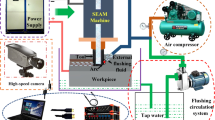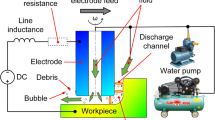Abstract
As a new development direction for electrical discharge machining, short electric arc machining (SEAM) has emerged as an efficient machining technology for difficult-to-machine conductive materials, as this method is not limited by the strength, hardness, toughness, and other mechanical properties of metal materials. In this paper, the pulse voltage, DC voltage, and DC superimposed pulse (comb) voltage were used as energy inputs to study the SEAM of Ti6Al4V. Experiments were carried out with a graphite tube material as the tool and Ti6Al4V as the workpiece. The current waveform of the experimental process was analyzed; the material removal rate (MRR) and tool wear ratio (TWR) were calculated; and the surface and cross-sectional micro-morphologies and micro-hardness were studied. The experimental results showed that the comb voltage input mode yields the highest machining efficiency, with an MRR of 19,620 mm3/min and a maximum current of 1475 A, which was 35 times higher than that in the conventional pulse voltage input mode. Moreover, the processing was more stable; however, the surface quality was poor. The study results are expected to help select an appropriate processing method depending on the process requirements.











Similar content being viewed by others
References
Shokrani A, Dhokia V, Newmann ST (2012) Environmentally conscious machining of difficult-to-machine materials with regard to cutting fluids. Int J Mach Tools Manuf 57:83–101. https://doi.org/10.1016/j.ijmachtools.2012.02.002
Dandekar C, Shin Y, Barnes J (2010) Machinability improvement of titanium alloy (Ti-6Al-4V) via LAM and hybrid machining. Int J Mach Tools Manuf 50:174–182. https://doi.org/10.1016/j.ijmachtools.2009.10.013
Su H, Liu P, Fu Y, Xu J (2012) Tool life and surface integrity in high-speed milling of titanium alloy TA15 with PCD/PCBN tools. Chin J Aeronaut 25(5):784–790. https://doi.org/10.1016/S1000-9361(11)60445-7
Fonda P, Wang Z, Yamazaki K, Akutsu Y (2008) A fundamental study on Ti-6Al-4V’s thermal and electrical properties and their relation to EDM productivity. J Mater Process Technol 202(1–3):583–589. https://doi.org/10.1016/j.jmatprotec.2007.09.060
Pramanik A (2014) Problems and solutions in machining of titanium alloys. Int J Adv Manuf Technol 70:919–928. https://doi.org/10.1007/s00170-013-5326-x
Han F, Wang Y, Zhou M (2009) High-speed EDM milling with moving electric arcs. Int J Mach Tools Manuf 49:20–24. https://doi.org/10.1016/j.ijmachtools.2008.08.005
Yadav U, Yadava V (2015) Experimental investigation on electrical discharge drilling of Ti-6Al-4V alloy. Mach Sci Technol 19(4):515–535. https://doi.org/10.1080/10910344.2015.1085316
Wang X, Liu Z, Hui Z, Qiu M, Tian Z, Cao Z (2016) Microcosmic mechanism of electrical discharge machining ablation on titanium alloy. Int J Adv Manuf Technol 83(5-8):929–935. https://doi.org/10.1007/s00170-015-7607-z
Gong Y, Sun Y, Cheng J, Wang C, Liu Y, Zhu Z (2016) Modeling and experimental study on breakdown voltage (BV) in low speed wire electrical discharge machining (LS-WEDM) of Ti-6Al-4V. Int J Adv Manuf Technol 90(5-8):1277–1292. https://doi.org/10.1007/s00170-016-9416-4
Kuriachen B, Mathew J (2016) Spark radius modeling of resistance-capacitance pulse discharge in micro-electric discharge machining of Ti-6Al-4V: an experimental study. Int J Adv Manuf Technol 85(9-12):1983–1993. https://doi.org/10.1007/s00170-015-7999-9
Zhao W, Xu H, Gu L, Hong H, Rajurkar K (2015) Influence of polarity on the performance of blasting erosion arc machining. CIRP Ann Manuf Technol 64:213–216. https://doi.org/10.1016/j.cirp.2015.04.032
Shen Y, Liu Y, Sun W, Zhang Y, Dong H, Zheng C, Ji R (2016) High-speed near dry electrical discharge machining. J Mater Process Technol 233:9–18. https://doi.org/10.1016/j.jmatprotec.2016.02.008
Kou Z, Han F, Wang G (2019) Research on machining Ti6Al4V by high-speed electric arc milling with breaking arcs via mechanical-hydrodynamic coupling forces. J Mater Process Technol 271:499–509. https://doi.org/10.1016/j.jmatprotec.2019.04.021
Zhou J, Liang C, Teng W, Xu Y, Zhou B (2008) Study on rules in material removal rate and surface quality of short electric arc machining process. Adv Mater Res 33-37:1313–1318. https://doi.org/10.4028/www.scientific.net/AMR.33-37.1313
Wang F, Liu Y, Zhang Y, Tang Z, Ji R, Zheng C (2014) Compound machining of titanium alloy by super high speed EDM milling and arc machining. J Mater Process Technol 214:531–538. https://doi.org/10.1016/j.jmatprotec.2013.10.015
Chen XK, Zhou JP, Wang KD, Xu Y, Hu GY (2019) Experimental research on the influence of dielectrics on short electric arc machining of GH4169. J Braz Soc Mech Sci Eng 42(1):1–12. https://doi.org/10.1007/s40430-019-2116-x
Li XZ, Zhou JP, Wang KD, Xu Y, Wu TB (2019) Experimental research on machinability of different electrode materials for SEAM of the nickel-based superalloy GH4169. Proc Inst Mech Eng C J Mech Eng Sci 232(24):4528–4537. https://doi.org/10.1177/0954406218755184
Liu K, Zhou J, Zhou Z, Xu Y, Hu G, Zhang L, Song D (2020) Milling performance of titanium alloy based on short electric arc machining with direct current power source. Int J Adv Manuf Technol 110:1641–1652. https://doi.org/10.1007/s00170-020-05937-z
Zhu G, Zhang M, Zhang Q, Wang K (2019) High-speed vibration-assisted electro-arc machining. Int J Adv Manuf Technol 101:3121–3129. https://doi.org/10.1007/s00170-018-3121-4
Zhu G, Zhang Q, Wang H, Wang K, Zhang M (2017) Machining behaviors of short electrical arc milling with high frequency and high voltage pulses. Int J Adv Manuf Technol 90:1067–1074. https://doi.org/10.1007/s00170-016-9399-1
Shen Y, Liu Y, Sun W, Dong H, Zhang Y, Wang X, Zheng C, Ji R (2015) High-speed dry compound machining of Ti6Al4V. J Mater Process Technol 224:200–207. https://doi.org/10.1016/j.jmatprotec.2015.05.012
Funding
This research was supported by the Natural Science Foundation of China (Grant No. 51765063), the Key Research and Development Projects in the Autonomous Region (Grant No. 2018B02009-1), the Research and Innovation Project in the Autonomous Region (Grant No. XJ2019G032), and the open topic research fund (Grant No. sklms2019009).
Author information
Authors and Affiliations
Corresponding author
Ethics declarations
Conflict of interest
The authors declare no conflict of interest.
Additional information
Publisher’s note
Springer Nature remains neutral with regard to jurisdictional claims in published maps and institutional affiliations.
Rights and permissions
About this article
Cite this article
Zhou, Z., Zhou, J., Liu, K. et al. Experimental study on short electric arc machining of Ti6Al4V in terms of power output characteristics. Int J Adv Manuf Technol 113, 997–1008 (2021). https://doi.org/10.1007/s00170-021-06683-6
Received:
Accepted:
Published:
Issue Date:
DOI: https://doi.org/10.1007/s00170-021-06683-6




